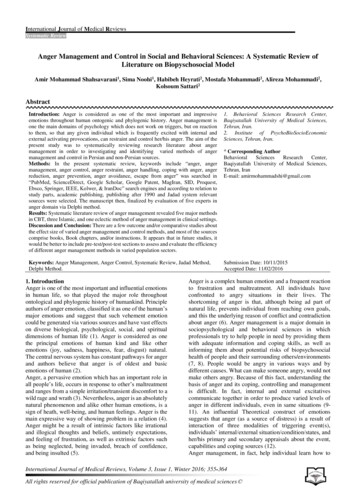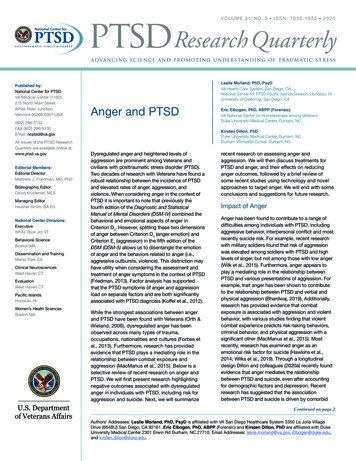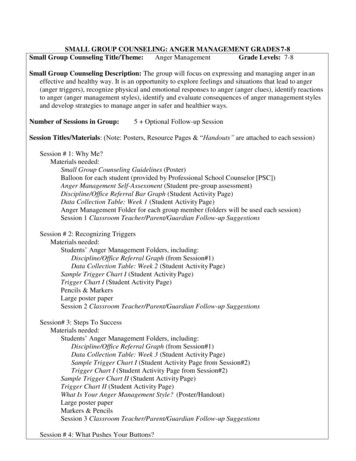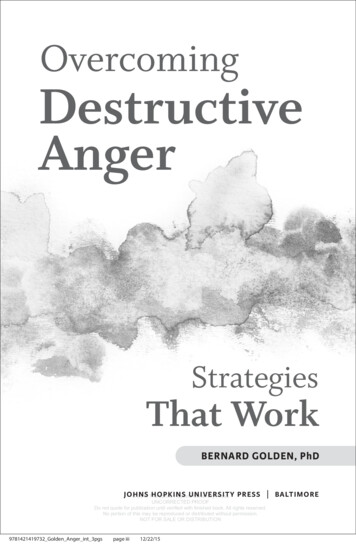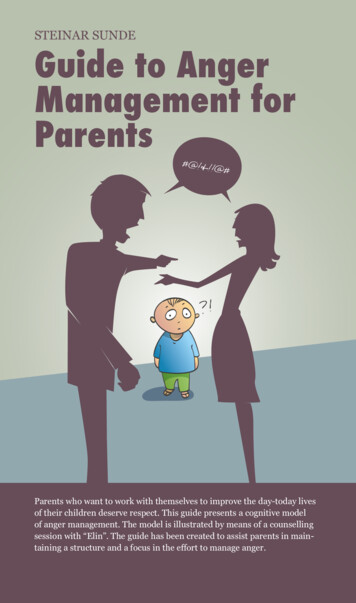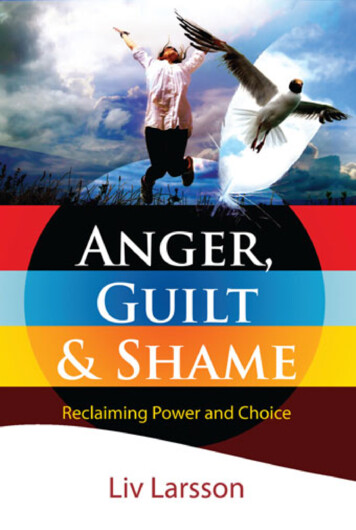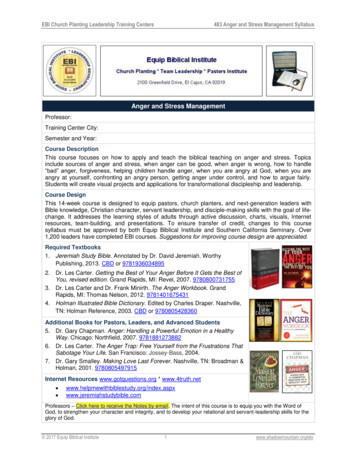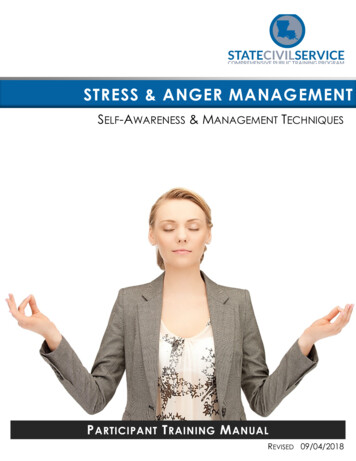
Transcription
The Anger Management ProgrammeISBN 978-0-9573280-3-72nd Edition January 2014
Programme Author: Brian A MartinMSc [TA Psychotherapy] CTA MNCH MBACPUKCP Registered Private practice as a Counsellor,Psychotherapist, Mediator andLife Skills Coach Based in Hinckley, Leicestershire, UK Specialising in Couples Counselling andAnger Management Masters Degree [TransactionalAnalysis Psychotherapy] Diploma in Counselling Diploma in Hypnotherapy Member of the British Association forCounselling & Psychotherapy [MBACP]Registered with theUnited Kingdom Council forPsychotherapy [UKCP]2
CONTENTSPart Page1.62.15Understanding your anger process3.28Keys to successful Impulse Control including -52Self Calming & Relaxation Audio Downloads4.60The ABC Impulse Control Technique5.76Releasing Anger & Frustration Safely6. 106Introduction to the programmeFurther optional readingAUDIO DOWNLOADS LINK: Page 59INDEX OF TOPICS: Page 114 - 1153
Changing habitual ways of behavingwon’t just happen because of whatyou will read in this programme.You have to work at it!There’s no magic wand!4
It’s not magic you need to prepare If you wanted to learn how toplay an instrument, walk a tightrope,juggle, or write a computer programme,it would be no good just reading about it,would it? Success in anything requirespractice! The aim of this programme is to changehabitual ways of responding angrily in somesituations. Knowledge alone will not do it –you need to follow the simple preparationsteps and practice the new ways of thinkingand behaving.5
The Anger Management ProgrammePART ONEIntroductionto theProgramme6
On successful completion of‘The Anger Management Programme’ You will be able to choose what todo instead of reacting with anger. Be better able to discuss thingscalmly and handle ‘wind ups.’ Know how to defuse angerdirected at you. Be able to release anger safelywithout hurting yourself or others. Be less stressed and feel angry andfrustrated less often.7
Sam and DanDuring the programmewe meet Sam and Danwho are experiencinganger, stress andrelationship difficulties.Illustrations byBarry AldridgeBarry Aldridge27@tiscali.co.uk13 8
Learning to understand andinterrupt the anger processThe Number One Priorityof the programme is to providean Impulse Control Techniqueto give control over angryand aggressive responses.Everyone has the abilityto control angry impulses,but many people haven’t yetlearned how to do it!IMPULSECONTROLIS NUMBERONE1PRIORITY9
Anger Management or Anger Therapy? There is no clear line between Anger Managementand Anger Therapy because Anger Managementis, in many ways, also therapeutic. Anger Management is about feeling calmer and resistingangry impulses. Its priority is behavioural change. Anger Therapy is about emotional health, about coping withthe present causes of anger and processing ‘unfinished business’from the past.I sometimes find that one or both of the partners in a coupleneeds to do personal one-to-one work to overcome eventsstopping them feeling loving towards each other.10
You should consider personal therapyor couples counselling if You may need to consult a therapistto complete your work if, at the endof this programme, you are still: Struggling with impulse control. Having bouts of rage. Feeling angry or hurt aboutevents from the past. Unable to express yourself assertively. Experiencing relationship difficulties.IF YOU ARE THINKING ABOUTHURTING YOURSELF ORSOMEONE ELSE YOU SHOULD GETPROFESSIONAL ADVICE IMMEDIATELY11
Working face-to-face with meI invite potential clients for an initial consultation to help them decidewhether sign up for the six session ‘Anger Management Programme’,or come for anger relief therapy, or both.At the time of writing the initial consultation is free[and without any requirement to book paid for sessions subsequently].To enquire about arranging a free consultationand to check my current fees please e-mail:brian@brianamartin.co.uk12
Mastering the techniques will take time Right now, you don’t know how to control your angryreactions in some situations. This is learning level one. At the next stage, when you have read the programmematerial, you will be aware of how to do it, but unableto do it consistently. Then you will be at learning level two. You will then progress to a stage where you can manage yourreactions consistently, but are still having to think about it.That is learning level three. Finally, you will be managing your responses without havingto remind yourself what to do. That is learning level four,the ultimate stage of all learning, and is called:-‘Unconscious Competence’.13
Be patient with yourself Be patient with yourself –there are no short cuts to‘Unconscious Competence’. You will have setbacks alongthe way. Some days you may thinkthat you haven't learned muchat all. Stick at it – with practice,the Impulse Control Techniquesin this programme are highlyeffective.Initially, your impulse to react angrily may remain strong –the difference is you will be able to control it!14
PART TWOUnderstandingThe Anger Process[so you can manage itbetter]15
It’s vital to be able to releaseanger and frustrationAnger Management is not aboutsuppressing anger – it’s the opposite, infact. It’s about resisting your angryautopilot reaction and learning torelease your anger and frustration inways which don’t hurt yourself or anyoneelse.If you ‘bottle up’ anger and frustrationyou will find it impossible to achieveself control. At some points you will‘blow’ with ‘over the top’ inappropriatereleases of anger and frustration.It’s also about learning to be angry less often.16
Anger has many dimensions Although I have sometimes used onlythe word ‘anger’ in this programme,I also include under this headingaggressive reactions caused by hurt,jealousy, feeling anxious, frustration,resentment and stress. In fact,any state of mind which may lead toan ‘over the top’ aggressive reaction. These feelings are perfectly naturalin all human beings. Problems resultwhen they are expressed or acted oninappropriately.17
Understanding your anger process:some key points We ALL have a last-minute warning from our bodywhen we are on the edge of ‘losing it’, so we have a fewseconds to choose not to [most people coming on theprogramme don’t believe this at first]. Anger display is often hurt feelings in disguise Alcohol switches our Impulse Control Switch to ‘OFF’ We give ourselves Permission to be aggressive We store anger and hurt stamps and often ‘rubber band’back to old angry feelings. Breathing to and from the diaphragm is deeply soothing Assertiveness is one of the main keys to overcoming angerANDWe can use humour to reduce anger.18
Anger is OK –It’s how you handle it that counts Anger is OK, it’s one of the core emotionsof all human beings. It’s normal to feel anger when we are facedwith unfairness and injustice. Anger is often a source of energy to rightwrongs and to protect those we love. There is nothing wrong with feelingand displaying anger - providing we don’texpress it, or act, in ways which hurtothers or ourselves. It’s certainly not OK to use anger displays tobully, manipulate and control others.19
The difference between anger and rage Anger usually has identifiable sources – thingsthat have happened or are happening whichcan be identified and focused on in angermanagement work. Rage is often without specific identifiable causesand may originate from early developmentexperiences in childhood. The person is not angryabout anything, or with anybody, in particular –but is explosively angry very quickly. Both anger and rage benefit from anger releasetechniques, but rage is more likely to needcounselling or psychotherapy too!20
How do you respondwhen angry or hurt?HOT RESPONSEAggressive,intimidatingbehaviourincluding verballyabusive rantsYour priorityis to learnImpulseControl andhow to beassertiveinsteadCOLD RESPONSEOr a mixtureof both?You need to learn torelease anger safelyand to use angerreduction techniquesPushing hurt andanger down inside.Fighting back inpassive aggressiveways includingbeing icy cold withthe other personwithout explainingwhyYour priorityis to learn tobe assertiveinstead21
When dealing with angerlook for the hurt behind the angerHurt FeelingsTransformedto angerI usually find that there are hurt feelings behind angry behaviour22
Emotional Trading Stamps How we store anger and hurt When we store angerand hurt it’s like collectingemotional trading stampsand cashing them in laterwith ‘over the top’ reactions. Unresolved anger and hurt isa major factor in stress. Unresolved anger and hurtneeds to be released in waysthat don’t harm yourself oranyone else.23
Displacement – known as ‘kicking the cat’is when we take it out on the wrong target When we are stressedwe tend to ‘take it out’on other people. Anger and frustrationmust be released, but noton the wrong person. Maybe you sometimestake out your stress onthe wrong person?24
Rubber Banding –Why past events still make us angry ‘Rubber Banding’ is a subconscious, automatic process,which causes us to re-experience feelings of hurt and angerfrom the past. When anything happening to us reminds us, at a consciousor subconscious level, of something in the past, we getthe same feeling now that we got then. We can find ourselves reacting with anger, hurt, or fear,to what’s going on: find ourselves reacting inappropriatelywith feelings which belong to the original event/s in the pastand not to the present. The aim of anger therapy is to ‘cut the rubber bands’ so we canrespond appropriately to the here and now and not replay oldfeelings.25
The rubber band whichpulls past feelings into the presentPast feelings ofanger, hurt or fearre-triggered in thepresent26
The impact of alcohol – you alreadyknow it .If you get angry when you havehad a drink, you need to avoid‘risky’ subjects and situationswhile under the influence.ChildsHeadMansBodyExcess alcohol switches offimpulse control methods taughtin anger management programmes.27
PART THREEKeys ToSuccessfulImpulseControl28
Impulse Control is about being able tochoose how to reactImpulse Control is the alternativeto an aggressive autopilot response.It’s about developing sufficientself awareness and self controlto be able to exercise choiceabout how to respond when feelingWhat shall I do?A, B or Churt, angry or frustrated.The ‘Anger Management Programme’teaches how to use the A B C‘Not Now’ model to switch off theaggressive autopilot and be in controlof your reaction.29
The six simple impulse controlpreparation steps which followStep 1 Make the decision to be in control of yourself.Step 2 Get rid of your False Beliefs about anger &Take Responsibility for your aggressive reactions.Step 3 Withdraw the Permissions you have given yourself& visualise being the way you want to be.Step 4 Make a list of your ‘Red Zones’ &and ‘Anger Triggers’.Step 5 Use the Last Minute Warningfrom your you body.Step 6 Learn to use Self Calming Breathing.30
Step One: Make the decision to takecontrol of the way you reactUntil YOU firmly decideto change the autopilotway you react when angry,frustrated or hurt you arestuck as you are!Determination to change isfundamental to success inchanging!31
Step TwoYou need to get rid of at two majorfalse beliefs you may haveMajor False BeliefNumber OneMajor False BeliefNumber Two‘My angry responsehappens in a flash.‘People, and thingsthat happen, causemy angry responses’.I don’t get a chanceto control it’.32
Why those two beliefs are falseFalse Belief Number One‘My angry response happens in a flash.I don’t get a chance to control it’.This is not true - because your bodyALWAYS gives you a last-minute warningwhen you are on the edge of ‘losing it’.You have just not been noticing the warning!It’s absolutely vital to your success on thisprogramme that you notice what your body is tellingyou! The last minute warning from your body givesyou a few seconds to decide how to react.33
False Belief Number Two‘People and things causemy angry responses’This is not true!XOf course, the things people do, and things that happen,can give rise to angry feelings and can ‘make you angry’, butno-one has a magic wand that can make you REACT in an angry way.It’s inevitable that sometimes you will feel angry,but how you react is ALWAYS up to you!34
Step Two [continued]Take responsibility for the way you reactTakeresponsibilityfor how youreact.Don’t blameloss of controlon others.Until you takeresponsibilityfor how youreact you arestuck.35
Step Three: Withdraw the Permissionsto be aggressive you have given yourselfIt may sound strange, but the fact isthat, without realising it, you haveso far given yourself permission,at a subconscious level, to behaveaggressively in certain situationsand with certain people.You don’t do it with everybody –so you do know how to controlyour anger when you don’t giveyourself permission not to.36
An example of how ‘Permissions’ work A former client of mine, a lorry driver,was acting out angry impulses at homeand his relationship was at break-up point.‘I just can’t help it’, he said. I asked him if he had any rude and awkwardcustomers. ‘Yes – lots’.‘Do you lose your temper with them?’ I asked.‘No, I’d lose my job if I did’. So he did not give himself permissionto ‘lose it’ at work – only at home!He knew how to manage his angerwhen he had not given himselfpermission to ‘lose it’. So can you!37
What Permissions have you been givingyourself? Do you respond aggressively when anyone: Forgets the way you like things done?Reminds you what you haven’t done?Reminds you what you have done – wrong?Says ‘’Don’t do it that way, do it this way’ ?Is slow, incompetent, or ‘thick’?Talks back at you?Makes a mistake which inconveniences you ?Doesn’t do things the way you think theyshould be done?Or when the children won’t do what you say?Or do you get aggressive when you screw upand feel angry with yourself?38
? Do you respond aggressivelywhen anyone .Criticises you or disagrees with you ?Is selfish, inconsiderate or rude?Belittles you: takes the mickey?Treats you as though you’re stupid?Embarrasses you in front of others?Is in a mood with you?Maybe, sometimes they didn’t mean tohurt your feelings, but that’s how youexperienced it? In other words, itmay be your interpretation, not whatthey meant, and you have taken itwrongly!Best to ‘check it out’before you takeoffence.Ask ‘what do youmean?39
Step Four: Make a list of your‘Red Zones’ and ‘Anger Triggers’ You already knowyour anger triggers.They are the thingsthat you have reacted toin the past. You could start bychecking yourself outagainst the list ofPermissionson pages 36 – 39.40
What triggers yourangry reactions?Anger Triggersare the specificthings thattrigger an angry,frustrated orhurt response.Triggers areflashpoints –specific types ofevent that youhave reactedangrily to in thepast.REDZONEAnger Triggersare the landmineslurking in your RedZones – yourhigher risk ofangry reactionareas.OK ZONE4141
Make a list of your ‘Red Zones’Where,whenandwith whodo you tendto get angry? ?Think of Red Zones as anger,frustration and hurt minefieldswhere you are at higher riskof hitting an anger Triggerand reacting aggressively. Red Zones are the ‘where’,‘when’ and ‘around who’ of anger.42
Where,whenandwith whodo you tendto get angry?HigherRiskZoneRed Zonesare placesandsituationswhere thereis a higherrisk thatsomethingmighthappenwhich couldspark anangryreaction.OK Zone4343
How to use Red Zone awareness Purpose One: PlanningSo you can think about how youwant to be when you next enterany particular Red Zone.Purpose Two: VisualisationSo you can visualise how youwant to be when you next enterany particular Red Zone. Purpose Three: Learn to noticeWhen you are entering a Red Zoneyou can remind yourself of howyou have decided you want to bewhen in that zone if you feelyourself getting angry.44
Red Zones and TriggersAn Example: RED ZONEWhen visiting your leastfavourite relative you areentering a Red Zone,a MinefieldAn Example: TRIGGERWhen you feel that you arebeing criticised by that leastfavourite relative during yourvisit that is a Trigger,a flashpoint45
More examples of Red Zones Any place or situationwhere you have ‘lost it’in the past. When driving and late. When doing a job youdon’t want to do. When with certain ofyour partner’s relatives. Any time you risk beingrefused what you want.A personal example:A Red Zone for mepersonally is whenI am with anyone from‘It’s more than my job’sworth’ brigade. You know,the officials who stick towhat seem petty rulesto stop them having to behelpful. I seem to meetmore of this type of personwhen dealing with banks,so going into my localbranch is a definite‘Red Zone’.46
Maybe most of your life is a Red Zone!? Maybe your relationship isin trouble and your partneris often angry, critical,or cold towards you. Or you are suffering fromstress at work. Or you have unresolved angerand hurt from the past orpresent.OUR REDZONESHigherINCREASERisk WHENWE ARESTRESSEDZoneOK ZONEPerhaps you are ‘an angry person’, with most of your life spent in oneRed Zone or another? If so, you should consider working with a therapistto resolve the underlying issues.47
Step Five: Learn to noticeyour last minute warningNeck andshoulderstensionAnxious or hotfeelings instomachClenched handsWhat last-minutewarning does yourbody give you?Itchy headTension in armsSweaty tremblinghandsIf you are not sure aboutyour last-minute warning, askyour family what they noticeabout you when you start toget ‘wound up’. One client didthis and discovered he alwaysused to rub his head justbefore the explosion!He had never noticed!48
You also get advance warning becauseyour anger triggers are very predictableFar from being a surprise, your anger triggersare almost totally predictable in advance!Why? because the situations in which youare likely to react badly in future arethe same situations in which you havereacted badly in the past!So you already know when you are likely toreact! How much notice do you need?The list of Permissions on pages 36 – 39should help you identify anger triggers.49
You get plenty of warning and plenty oftime to prepare! The situations in whichyou are likely to react badly in futureare the same situations in which you50have reacted badly before.
How to use your advance warningsIf that happenswhat I’ll do is .PlanningSo you can think about howyou want to handle each of youranger triggers when you hit them.VisualisationSo you can visualise yourselfhandling each trigger the wayyou want to.51
Step Six: Learn to breathe differentlywhen you want to calm down We are programmed by evolution to take a deep breath,or hold our breath, when faced with danger. If you takea deep breath now you will notice how your chest rises. When you breathe in that way you are sending a warning signalto your brain ‘I am facing a threat, get ready for action:get ready to fight, run or freeze’. So when you want to calm down you need to breathedifferently. This different way of breathing is called‘Diaphragmatic Breathing’52
Use Diaphragmatic Breathing when youwant to calm downDiaphragmatic Breathingsends a different sortof signal to the brainbecause it is a wayof breathing we wouldnever naturally use whenfaced with threat. It’sa way of breathing whichsends a signal to thebrain ‘Everything is OK.It’s safe to relax.’In Diaphragmatic Breathingyou fill your lungs from thebottom up by pushing yourtummy out as you breathe indeeply. This allows thelower part of your lungs tofill first.As you continue to breathein and your lungs fill, yourchest will rise too – that’sOK, as long as yourdiaphragm expands first.53
Diaphragmatic BreathingWRONGWAYInflatechest firstand signalto brain‘Danger!Get readyto fight,run orfreeze’.RIGHTWAYPush outtummy toallow lungsto expanddownwards.Send signalto brain‘Safe’.54
How to practiceDiaphragmatic Breathing1.Lie down and make yourself comfortable.Put one hand on your chest and the otheron your diaphragm.2.Slowly take a deep breath, pushing yourdiaphragm out. Feel your diaphragm risingand not your chest.3.Count to three before breathing out.4.Breathe out fully, feeling your diaphragmfall. Pause for 3 seconds before breathingin again.5.Repeat steps 1 – 4 for at least five minuteseach time you practise.To download a free audio version of the exercises in this book please 5
Using Diaphragmatic Breathing to‘Anchor’ a relaxed state An ‘Anchor’ is a physical thing you do to connectwith a pre-programmed mental state.In this case, the Anchor is deep DiaphragmaticBreathing and the pre-programmed mental stateresulting is calmness. To set your Anchor, in other words to make theneurological connection, practise the breathingexercise on the previous slide while listening toa piece of beautiful music at a time, and in aplace, where you are unlikely to be disturbed.56
Intensify yourSelf Calming Anchor Put on a beautiful piece of music [no vocals please]. Settle yourself comfortably and switch your breathingto Diaphragmatic Breathing. Each time you breathe in, imagine that you are gradually beingfilled with a beautiful white soothing light which is filling youwith feelings of peacefulness. Each time you breathe out let go of any tension you are holdingin your body. Feel yourself relax more and more with each outbreath. Practise this at least once a week for 20 minutes or more.57
Visualise anger Triggers while self calmingPart One:Make time to practise thisat homeMake yourself comfortable,select one of your angerTriggers, change your breathingto Diaphragmatic Breathingand imagine yourself handlingthe situation the way you havedecided to handle that situationin future.Part Two:Practise this when outand aboutIf angry thoughts aboutone of your anger Triggerscome into your headhold on to the thought andchange your breathing toDiaphragmatic Breathing.Continue this until theangry feeling subsides.Repeat as necessary.58
Free Downloadable Hypno Audio TracksTrack 1Introducing the tracks followingTrack 2Diaphragmatic breathingTrack 3Setting your Self Calming Anchor Peaceful Place visualisationTrack 4Impulse Control PreparationTrack 5Tomorrow Box visualisationTrack 6Yesterday Box visualisationTrack 7Deep Relaxation MusicTo download please or More Deep Relaxation & Self Calming Tracks visitwww.selfcalming.co.uk59
PART FOURThe ABCImpulseControlTechniqueAlso known asthe‘NOT NOW’Technique60
How to interrupt your anger process1Noticeyourselffeelingtense – thelast-minutewarning yourbody isgiving you.2Switch toDiaphragmaticBreathing.3CHOOSEA or B or C61
The A B C of choiceswhen you feel angryALet your angry/hurt reaction autopilot take over.BBe assertive [see Pages 89 – 92 & 70 – 73] there and then.Good idea, but probably you are not in the right frame of mindto do it well. Timing is everything.CChoose ‘NOT NOW’.Decide to ‘let it go’ for the moment and deal with itlater when you feel calmer.Highly recommended.62
The ABC Impulse Control TechniqueWhen entering a Red Zone .A Red Zone is any situation or place whereyou are more likely to run intoan Anger Trigger [Pages 40 – 41]When entering a Red Zoneuse your Self Calming technique [Pages 52 - 57]1. Change your breathing to deeper, slower,Diaphragmatic Breathing.2. Notice that you have begun to feel calmer.3. Remember how you planned to be in thatRed Zone should you feel an angry reactionbuilding up.63
If you run into an Anger Triggerfollow this Impulse Control process1Noticeyourselffeelingtense – thelast-minutewarning yourbody isgiving you.[Pages 48 - 51]2Switch toDiaphragmaticBreathing[Pages 52 - 57]3CHOOSEA or B or C64
When you run into a trigger notice yourbody’s warning, breathe deeply, and . .chooseALet your angry/hurt reaction autopilot take over.BBe assertive [see Pages89 – 92 & 70 - 73] thereand then.Good idea, but probably you will not be in the right frame of mind to do it well.CChoose ‘NOT NOW’.Decide to ‘let it go’ for the moment and deal with itlater when you feel calmer.65
Choice C1 - let it go fornow - decide later‘it’s not worth botheringabout’ and let it go.Use the 0 – 10 scale ofimportanceREDZONEChoice ALet AngryAutopilot Take OverAChoice BAttempt to discussassertively there andthenChoice C3 - letit go for now –discussassertivelylaterChoice C2 - letit go for now use AngerReleasetechniques toprocess angryand hurtfeelings laterTRIGGERSChoice C When you run into ananger Trigger decide ‘NOT NOW’, bepassive [for the time being at least]and choose C1, C2 or C3 later66 66
Choice A - letting your angry/hurt autopilottake over, is rarely the best choiceIt’s likeusing petrolto put out afire!67
AfterwardsIf you didn’t get it right - learn from it!What do you need to do to get it right nexttime? If you hit a new Trigger add it to yourlist of Triggers and decide how to handleit the next time it happens.If you handled itthe way you planned give yourself a treat!If you are leftwith anger,frustration,hurt or othernegative feelings .68
When you choose C, the ‘Not Now’option, you may decide later to ‘let it go’In which caseHow important is what happenedon a scale of 0 - 10? Maybe Ishould just ‘let it go’the ‘Shrinkingthe Importance’techniques onpages 97 & 99will help.69
Or you may choose not to ‘Let it go’ andtry to discuss what happened assertivelyIn which case it would be helpful toset up a meeting and follow the rulesfor a civilised discussion [next].If you can think of the other personas a good person who did somethingwhich upset you – rather than a badperson – you will find it easier tostay calm.Bad behaviouris not the samething as badperson!70
An assertive approach [see pages 89 - 92]‘Contracting’ for a Civilised Discussion A ‘Contract’ for a Civilised Discussion’ [next]is a way of trying to discuss calmly what’supset you. The ‘Contract’ should have a ‘TIME OUT’clause. This is a prior agreement that allowseither party to withdraw from the discussion,for a period of minutes, hours, even days,if things get too heated. The idea of ‘Time Out’ is to allow a cooling offperiod.If you and your partner can’t discuss thingscalmly, you should definitely consider couplescounselling or mediation.71
The Civilised Discussion ‘Contract’should include the following .1.The issues for discussion agreed in advance. Don’t bring in other issues.2.Location is a place where you will not be interrupted.3.TV and mobiles switched off. House line ignored if it rings.4.No abuse or shouting. Parties remain seated throughout.5.Have a ‘TIME OUT’ agreement [page 71].6.Have ‘Uninterrupted speaking time’ rule [next]7.Try to stick to the facts and avoid opinions.If you feel criticised it may be paranoia!Check it out by simply asking,‘What do you mean?’72
Uninterrupted speaking time Questions and explanations should be saved untilthe speaker has completed their allocatedspeaking time without interruption. Speaking time should be in equal amountsof say, five or ten minutes at a time, each. If either of you don’t use all your time,the other person still gets the time agreed. Have a pen and a rule that the one whose turnit is to speak holds the pen and may not beinterrupted while holding the pen.x‘Uninterrupted Speaking Time’ is a key featureof a Civilised Discussion. It means just that!Absolutely no interruptions of any kind.X 73
Setbacks are not failure When you get it wrong,as you sometimes will,[because you are human,not a robot or a computer]remember it’s a setback,not failure.Just get back on track. After all, if you set out to gosouth and found yourself onthe road north, you wouldn’tthink ‘I failed’ and keep goingin the wrong direction, wouldyou!74
As you progress you will notice that you feel angryless often and that you get over things more quickly.Remember the four stages of learning[pages 13 - 14]. When you get it wrong, planhow you will handle that situation betternext time.75
PART FIVEReleasing Anger&FrustrationSafelyIF YOU ARE THINKINGABOUT HURTING YOURSELFOR SOMEONE ELSE YOUSHOULD GET PROFESSIONALADVICE IMMEDIATELY76
Anger & frustration releaseis essential On page 23 I wrote abouthow we store anger and hurt asemotional trading stamps whichwe then cash in inappropriatelywith ‘over the top’ reactionsto incidents. Unresolved anger and hurtneeds to be released in waysthat don’t harm yourselfor anyone else.77
THE CUP OF POISON Hanging on to angeris like sipping from a cup ofpoison in the hope that it willsomehow even the score. That poison increasesstress, impairs abilityto manage anger anddamages emotional health.78
Unresolved anger and hurt leads to‘Displacement’ – also known as ‘kicking the cat’Unresolved anger and hurtis like a kind of pressurisedpoison gas which keepsleaking out, causing us toreact ‘over the top’.We find ourselves reactingaggressively at the wrong time,in the wrong place, or with theCheck yourself out whenyou are feeling angry withsomeone – is the way youfeel directed at the righttarget or are you ‘taking itout’ on the wrong person?wrong person. This is known as:‘DISPLACEMENT’ or‘KICKING THE CAT’79
It’s been said countless times.Who said it first?I don’t know, but a philosopher by thename of Epictetus is one who said, over athousand years ago ‘It’s OK to be angry and essential to releaseanger, but to release it in ways which arenot harmful to self or others.’According to Epictetus safe anger releaseis about choosing: The Right Time The Right Place The Right Way The Right Reason The Right Length of Time The Right Person To Be Angry With80
Alcohol is the enemy of impulse controlThis is why excessalcohol is such a bigproblem. Under theinfluence of alcoholpeople oftenDISPLA
and Anger Therapy because Anger Management is, in many ways, also therapeutic. Anger Management is about feeling calmer and resisting angry impulses. Its priority is behavioural change. Anger Therapy is about emotional health, about coping with the present causes of anger and processing 'unfinished business' from the past.

